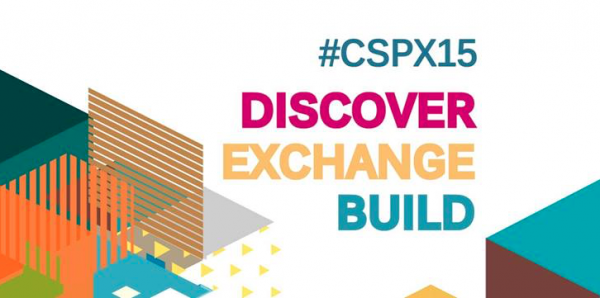What: Creative Spaces Partnership Exchange
When: Monday, November 2
Where: Toronto Centre For The Arts, 5040 Yonge St (Yonge and Sheppard)
Cost: This is a free event; register here
This Creative Spaces Partnership Exchange is the signature event for an Artscape-led initiative called Creative Spaces Outside the Core (CSOC), developed in 2013. The event is designed to support the development of community cultural hubs and other cultural spaces outside the downtown core. The event, happening November 2, offers an exhibitors fair, workshops, lightning talks and area-specific, networking meetups.
The event should attract city-builders and culture makers of all sorts; be they arts projects, arts organizations, arts spaces, public agencies, funders, developers, others from the private sector, or service organizations. “We’re expecting this to be quite a significantly larger event, one that’s focused on capacity-building in a more formal way in response to some of the suggestions that came out of last year’s event,” explains Pru Robey, VP of Artscape.
Spacing is an event sponsor and will also be an exhibitor, so we spoke with Robey to discuss what to expect at this year’s event.
Spacing: What were you looking for when selecting the event partners?
Robey: We’ve now gathered up to 60 exhibitors and are quickly running out of space. We were looking for organizations that were either based outside the downtown core, or had an interest in connecting to and partnering with organizations outside the downtown core. When you look at all the exhibitors, you see a real range and scale of the projects and organizations created through our various partners across the city.
We selected the Toronto Centre of the Arts this year as our presenting partner, largely because it’s a fabulous facility currently undergoing a revitalization and re-facing itself back to its community. Also, it’s located in North York. Our first partnership exchange event was held at the Etobicoke Assembly Hall, so it was time to go into another part of the city for this event.
Spacing: The event is framed as “a partnership exchange”. What do you hope attendees will take away from the event?
Robey: The centrepiece of this event is an exhibitors fair; a cross between a science fair and a trade fair. New this year are sub-regional facilitated networking and capacity-building meetups. I hope people will leave knowing that there’s a rich range of opportunity for creating cultural activity and space activation outside of the downtown. Also, that there are a wide array of partnerships who are excited by the opportunity to further enrich existing cultural spaces, and also explore the development of creating new cultural spaces.
I hope at a deeper level, that people will go away with the appreciation of the complexity of putting cultural space projects together – especially putting ones together that are sustainable for the long-term and actually serve the community in which they’re based. In our research we’ve found that projects are most likely to be successful when partners from a range of sectors come together to bring about that activity. This isn’t the cultural sector talking to the cultural sector, or the public sector speaking to itself.
This is about an understanding that to really advance this conversation about how to address the disparity of cultural facility provisions in the city, we have to think about how to work together with different sectors to align our shared values, interests and resources.
Spacing: What topics did you feel were important to cover/discuss in the workshops?
Robey: We wanted to address a number of key systems that emerged through our partnerships, and especially that emerged through a roundtable exercise we did in 2013, which helped to frame a lot of this narrative.
- The importance of cross-sector collaboration; how one goes about that, what that looks like, the challenges and opportunities around building collaborative partnerships (across old silos).
- Approaches to building projects from the ground-up through community engagement; how one actually goes about engaging community in a meaningful conversation, how one develops cultural infrastructure and programs that meaningfully serve communities, and how to cultivate a community of revitalization at the same time.
- Exploring new models. For example, the community hub idea. What does the idea mean? What does that look like? What is community hub model?
We also have an exploration of inspiring different projects through a lightning talk series.
Spacing: Why is it important to draw attention to spaces outside of the downtown core when working towards creating more cultural spaces?
Robey: The reality is the significant majority of arts and cultural activity and investment is heavily concentrated in a very small part of the downtown core. If you amass research from over 5-7 years, that’s what you see. There are clusters of activity across the city, and there’s also a lot of hidden activity that’s happening at a community level in unusual places and spaces that may not get picked up. But the reality is that there is a dense concentration invested downtown which has resulted in inequitable access to arts and cultural activities across Toronto’s neighbourhoods.
We believe that cultural space is a critical component of city-building, to the vitality of neighbourhoods, to the well-being of resident communities, to building social capital inclusion, revitalization, economic sustainability, etc. For both individuals and the community, there’s enormous benefit that flows from that kind of structure and activity. A large part of our city doesn’t have access to that and in many ways, many of the areas that could most benefit from that transformative power, including the inner suburbs, often have the least. As a result of that, they often haven’t built up the community-kept capacity and leadership necessary to develop cultural infrastructure. This is not just an issue for culture, this is an issue that is equally significant to other forms of community service provisions as well.
We know the arts have the power to make enormous contributions to communities. The birth of community and cultural infrastructure outside the core is a policy priority in Toronto, as well as the Toronto Arts Council. This is one of many initiatives to try and tackle this issue.
For more information, visit the event website.




